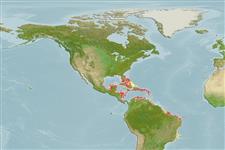Demospongiae |
Dictyoceratida |
Spongiidae
Environment: milieu / climate zone / depth range / distribution range
Ecology
Sessile; brackish; depth range 0 - 5 m (Ref. 108813). Tropical
Western Central Atlantic.
Length at first maturity / Size / Weight / Age
Maturity: Lm ? range ? - ? cm
Massive growth form.
Combination depth range: min from estimate, max from literature.. Occurs in mangrove ponds (Ref. 86789).
Life cycle and mating behavior
Maturity | Reproduction | Spawning | Eggs | Fecundity | Larvae
Members of the class Demospongiae are hermaphroditic. Life cycle: The zygote develops into parenchymella larva (free-swimming) before settling down on a substrate where it grows into a young sponge.
Rützler, K., M.C. Diaz, R.W.M. van Soest, S. Zea, K.P. Smith, B. Alvarez and J. Wulff 2000 Diversity of sponge fauna in mangrove ponds, Pelican Cays, Belize. Atoll Research Bulletin No. 476, National Museum of Natural History, Smithsonian Institution, Washington, D.C., USA. (Ref. 86789)
IUCN Red List Status
(Ref. 130435: Version 2025-1)
CITES status (Ref. 108899)
Not Evaluated
Not Evaluated
Threat to humans
Human uses
| FishSource |
Tools
More information
Trophic EcologyFood items (preys)
Diet composition
Food consumption
Predators
Population dynamicsGrowth
Max. ages / sizes
Length-weight rel.
Length-length rel.
Length-frequencies
Mass conversion
Abundance
Life cycleReproductionMaturityFecunditySpawningEggsEgg developmentLarvae PhysiologyOxygen consumption
Human RelatedStamps, coins, misc.
Internet sources
Estimates based on models
Preferred temperature
(Ref.
115969): 25.2 - 28.3, mean 27.1 (based on 270 cells).
Price category
Unknown.
